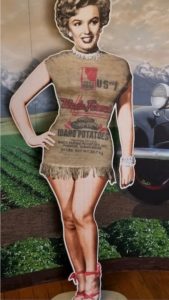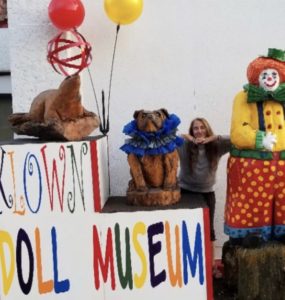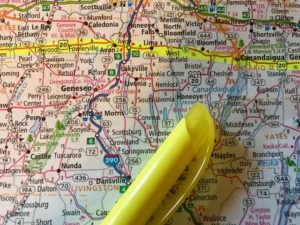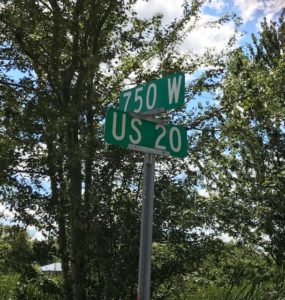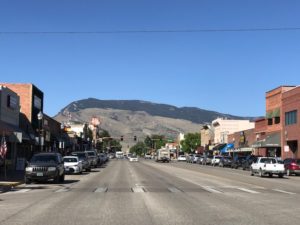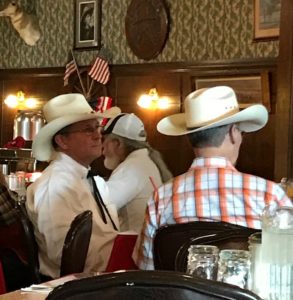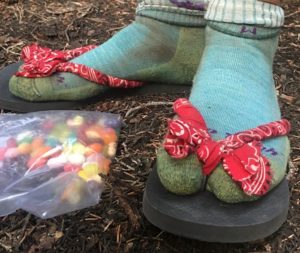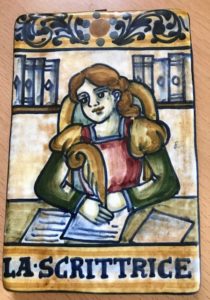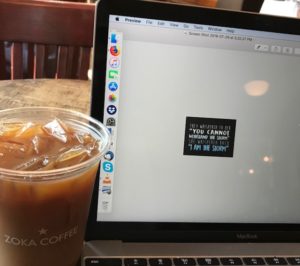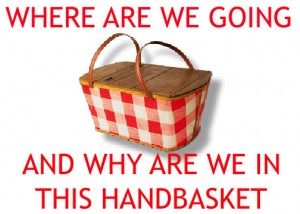Category — Life
Route 20 Report #5
And now, musings from my reporters’notebook (Oregon and Idaho):
Drewsy, Oregon, Harney county, just east of Stinkingwater Creek. The guy who settled here applied for an official post office under the name Gouged Eye (to “commemorate” a local fracas). The name was rejected.
There is a Bates Motel in Vale, Oregon. And it looks just like you think it would look.
In Nyssa, Oregon, just past a huge billboard proclaiming “Cowboys Lives Matter,” is a hip little coffee stand named “Cappuccino Cowgirl.” Uh huh.
A quick stop in Atomic City, Idaho (population 26), home of Experimental Breeder Reactor I, the world’s first electricity-generating nuclear power plant. There is one store and one bar in town. Most of the people raised here are dead. The median age of those remaining is 59.8. (zero percent are 18 or younger).
At the Golden West Café in Arco, Idaho (the first city in the world to be lit by atomic power—see above), walking out the door: A 30-ish blond woman carrying a blond infant, holding the hand of a 6-year-old blond girl who is balancing a blond toddler on her hip. We are deep in Mormon country.
Idaho Potato Museum, Idaho Falls, where there are “free ‘taters for out-of-staters” (box of dehydrated hashbrowns that will feed six people), where there is not only a collection (behind glass) of vintage potato peelers but also another curated collection of potato mashers, where there is a life-sized stand-up of Marilyn Monroe in a potato sack (and yes, she is still gorgeous). Possibly The Best Museum Ever.
At the Riverside RV Park in Bellevue, Idaho, #15 on list of park rules: “NO SMOKING OR ALCOHOL IN BATHROOMS.” As if.
October 3, 2018 No Comments
Route 20 Report #4
What can I say about Nebraska?
That I was dreading its 431.6-mile length? That “sandhills” sounded like a euphemism for craplands? That Willa Cather notwithstanding, I figured the only way to make it through was to binge-listen to Elmore Leonard audiobooks? That Nebraska would be the least interesting state on our Route 20 cross-country trek?
Boy howdy, was I wrong.
I loved Nebraska. And here are a few of the many reasons why:
Chadron, home of the extraordinary Museum of the Fur Trade where we saw not just the penis bone of a raccoon (as if that was not enough), but a rain jacket made of seal intestines.
Rushville, where I had this conversation with the postmistress after she told me she’d moved to town 35 years ago and could not imagine living anywhere else:
What do you love most about this town?
(No hesitation) The water! It’s the best!
Where does it come from? (I am thinking artesian well, deep aquifer)
(She points) There! From right there!
(She is pointing at the town’s water tower)
Valentine, where until 1967, half the town was in Mountain Time Zone, half in Central. Like right down Main Street. Also the Pacific-to-Atlantic Route 20 and the Mexico-to-Canada Route 83 cross here. Like right on Main Street. And, best yet, the extraordinary Fort Niabrara National Wildlife Refuge where prairie dogs came out of their holes to click and chatter at us.
Plainview (pop. 1,200), where a huge sign invited us to camp for free in the city park. So we did. The park was directly across from the Klown Doll Museum. Yes, with a K.
Laurel (pop. 964) where we had an “anything you want, we’ll make it” breakfast at Friendly Corner, a donation-only restaurant that supports a youth center. The other patrons that morning were ten octogenarians celebrating the 92nd birthday of the lady at the head of the table.
I leave you with these opening lyrics to Nebraska’s state song:
Beautiful Nebraska, peaceful prairie land
Laced with many rivers and the hills of sand
Dark green valleys cradled in the earth,
Rain and sunshine bring abundant birth.
The author is said to have composed the original piece in an hour. “I was lying in a pasture and words just came to me,” he said.
Uh huh.
September 26, 2018 2 Comments
Route 20 Report #3
In a coffee shop in Canandaigua, New York, at the top of the Finger Lakes, I ask the guy behind the counter where I can buy a yellow highlighter pen. I’ve lost the one I’ve been using to mark our cross-country Route 20 journey in the huge Rand McNally atlas I keep wedged between the seats. Yes, of course, we have GPS. But the map is a cartographic diary. I love inking our way across the country. I feel lost without my marker.
The guy gives me complicated directions to a distant Walmart that I know I will not be visiting. The fact that there is a Walmart around here is disturbing enough. We’ve been 16 days on a Walmart-free road, the road not taken, because why would anyone travel coast to coast on a two-lane highway that goes through hundreds of one-street towns (slowing down to 30 mph) when you could just zip through on a freeway.
Why? Maybe the little story below helps answer that question.
I go back to the counter to get my coffee, and an older man comes up to me. He apparently overheard my query about the highlighter. He tells me there’s a stationary store just down the street, but he isn’t sure they sell pens. We laugh about that. Then I sit down with Tom and enjoy the first cup of espresso-style coffee I’ve had since we happened onto a Starbucks inside an Albertson’s back when we were re-provisioning in somewheresville, Wyoming.
Ten minutes later, the older man walks up to where we’re seated and places a yellow highlighter on the table. I hadn’t noticed that he’d left the coffee shop. But he had. He had walked down the street to the stationery store. As he thought, the store did not sell pens. He left. He was halfway back to the coffee shop when the storeowner caught up with him on the street, brandishing a yellow marker. “I found this in the backroom for you,” she told him.
And that’s how I got a new yellow marker.
And that’s what route 20 is all about.
September 19, 2018 2 Comments
Route 20 Report #2
What lies between the coasts? That question is at the heart of this 3,365-mile trek, Pacific to Atlantic, along Route 20. It is now the end of day 14, and I am writing this sitting in a tent in a campground on the shores of Lake Erie. The sunset over the lake was vermillion. The crickets have started in. Every 30 seconds an acorn drops from a tree. I can hear a train way off in the distance.
I was born on one coast, and I’ve made my life on the other. Before this trip, I was not ignorant of what lay between west and east. I had put in time in the Midwest. I had crisscrossed the country on I-80, I-90 and I-40 at various times in my life.
But then 2016 happened. And, like so many people, I all of a sudden didn’t think I knew my own country anymore. So that’s what this trip is about.
I’m discovering too much to write about here. And my ah-ha moments come and go, from attempting to understand gun culture to thinking about the meaning of family to wrapping my head around the place of corn in U.S. agriculture—and I don’t mean “sweet corn.” I mean corn used for ethanol, corn used for high fructose corn syrup, mono-culture, endless fields of it.
But one simple (maybe self-evident) thing I’ve discovered is that small towns (that is, most of the towns along Route 20) are more alike than not, whether they be Shelley, Idaho, or Thermopolis, Wyoming; Rushville, Nebraska or Elizabeth, Illinois; or (today) Westfield, New York. The places you never heard of. The places you would never visit unless your great aunt lived there. Some are more prosperous than others. Some are more beautiful than others. All are pretty proud of themselves. All are populated by people who mean no harm (speaking as the white, traveling-through person I am, you understand). The people seem genuinely friendly. They seem to care deeply about each other. The kids—contrary to what I thought—choose to STAY. They all have newspapers, most dating back to the late 1800s. In the cafes, they play the same country music.
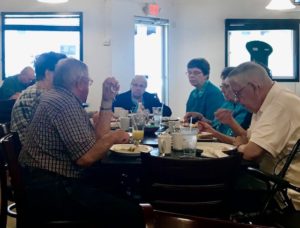 (Celebrating Selma’s 92nd birthday.
(Celebrating Selma’s 92nd birthday.
Breakfast at Friendly Corner, Laurel, Nebraska)
September 13, 2018 4 Comments
Route 20 report #1
It’s day 6 of the #insearchofamerica #route20 #carcamping #coasttocoast #roadtrip (because, you know, Instagram).
We’re in Thermopolis, Wyoming, where we stopped to soak our tent-sleeping bodies in the largest natural hot springs in the world (who knew) and soak our camping-grimy clothes in the Thermopolis Wishy Washy Washateria.
There is too much to write about. When you have a different, vastly different, experiences every day, when the landscape changes hour by hour, when random conversations with locals open your eyes to our similarities and our differences, when you spend every night in a different spot, when the thrum of the two-lane road gives you ample time to think…there is too much to write about.
But here are a few thoughts and a few images from the road.
People out here are not “pro” guns the way others (like me) are “anti” guns. It doesn’t appear to be an “issue” one reasons through. I don’t mean people out here are not thoughtful. I mean guns are so embedded in the culture, so much a part of daily life that you’re not “for” them. They just are. Like a pair of shoes. Like a hairbrush. The issue comes in when we attempt to (in ANY way) regulate what they take for granted. A few days ago, outside Nyassa, Idaho, we passed a huge billboard on route 20: “Any regulation takes away freedom.”
You talk to a person in one of these one-street towns along the way, maybe she’s the waitress serving you eggs and sausage at the Abacadabra Café or the guy giving you advice about which washing machines are the best at the Thermopolis Wishy Washy Washateria, and you ask them: “What do you love about this place? Why do you live here?” And they look at you uncomprehendingly. “My family is here,” they say. It’s that simple. Ask someone in Portland, Oregon the same question.
And just one more thing: The only Starbucks in Cody, Wyoming is in an Albertson’s. We stopped there. The soft-bodied, super-friendly woman behind the counter took our order. “Okay,” she said. “We’ll have that for you in…” she looked over at the woman working the espresso machine. “In a while.” She laughed. And it did take a while. And that was perfectly fine. Because it gave us a chance to have an impromptu conversation with a woman whose daughter runs the Meeteesi Labor Day celebration. Which we really should see. Because it’s really something.
September 4, 2018 6 Comments
Anticipation
It is one day, almost exactly 24 hours, before we leave for our “we’ve all come to look for America” “discovering the land between two coasts” “what’s up with this country anyway?” “deTocqueville meets William Least Heat Moon” cross-country trip. We’ll be car-camping across the northern heartland on the only non-freeway, old-style 2-lane road in the U.S. that runs from coast to coast.
No, not Route 66, the “Mother Road.” That ran only from Chicago to California and is now chopped up anyway. I’m talking about humble route 20, which starts in Newport, Oregon, traverses the vast, sparsely populated, deep Red width of Oregon, then meanders through the girth of Idaho, dips into Yellowstone, makes its way across the sandhills of Nebraska, into Iowa (Fort Dodge!), then a snippet of Illinois (beginning with the lovely town of Galena, birthplace of U.S. Grant). Then it’s northern Indiana and Ohio (can you say audiobook) before ambling through the New York Finger Lake region (and Seneca Falls, birthplace of the woman’s suffrage movement) and into the Berkshires of Massachusetts (yes, the Camp Tamarac of my youth). Route 20 ends, 3,365 miles later, in Boston.
Am I excited? Buoyed by anticipation? Hell ya.
In fact, research shows that this is the happiest I am going to feel about this adventure. A study by Netherlands social scientists (they interviewed more 1,500 people) found that vacationers were most happy before their trips. Planning, anticipation, thinking about all the fun and adventure—that’s the best. The trip itself? Who knows? Tedium, bad diner food, frigid mornings in the tent, domestic squabbles. Just sayin.
So right now, this moment, I’m going to enjoy the hell out of this trip.
More to come.
August 29, 2018 7 Comments
Hiking the PCT
Approximately a zillion years ago, I wrote a book ON A TYPEWRITER. It was a brisk 20th century history of U.S. political dissidents and cultural outsiders, and the newspapers and magazines they started to promote their causes. Each of these groups was itself a subculture—abolitionists, utopianists, feminists, war resisters—but within the subculture, there were invariably splits, splinters and “purges.” I wrote about Marlenites and their little newspaper. The Marlenites consisted of a few members of the Marlen family. They were a splinter group of a splinter group of a splinter group of the American Communist Party.
Oddly, I was thinking about all this as I hiked a stretch of the Pacific Crest Trail (PCT) these past few days. We (son, daughter-in-law, son) had already played twenty questions, name that tune and Stinky Pinky, and there were many miles to go before we made camp. Trudging through scraggly pine forests (I am a Doug Fir girl) with a 28-pound pack on my back, what else was I to do other than contemplate dissident journalism?
Thinking about these splinter groups, these sub-cultures of sub-cultures, my thoughts turned to the PCT subculture. For those who’ve never been on the trail—it stretches 2,650 miles from the Mexican to the Canadian borders (and no, Cheryl Strayed did not hike its entirety)—let me give you a snapshot: PCTers are overwhelmingly white, educated, moneyed, late 20s to mid-30s, and, not surprisingly, leaner and healthier than almost everyone else in America. Of course, there are exceptions. Me, for example. (Just the age thing. Oh, and the lean thing.)
As I learned the lore of the trail from Zane and Liza who had started at the Mexican border back in late April, I began to understand PCTers as less homogeneous than I originally thought. Yes, they were mostly white, educated, moneyed, lean and thirty, but there were thru-hikers and section-hikers and day-hikers. There were SOBOS (southbound) and NOBOS (northbound). There were slack packers (someone else transported their packs for them). There were ultralight folks (base weight of pack 10 pounds or less). There were yellow blazers (they cheat by hitchhiking), blue blazers (they take short-cuts) and pink blazers (they’re on the prowl for, um, tent-mates).
And it seemed that people within each group had strong opinions about people in the other groups. Thru-hikers were the real deal. They considered section-hikers inferior beings. Repeat thru-hikers were really the real deal. They considered everyone else inferior beings. SOBOS ranked higher on the PCT-o-meter than NOBOS. Ultralighters were admired by others, but not as much as they admired themselves. And so it went. A tiny subculture (a few thousand hikers, maybe 700-800 who attempt thru-hiking ) splintering into sub-group after sub-group.
If you don’t see the connection between PCT culture and dissident journalists, you would about 17 miles down a hot trail with a (did I mention?) 28-pound pack on your back.
(photo: Camp feet with Jelly Bellies. All hail Darn Tough socks)
August 22, 2018 No Comments
I believe
What do you do when something you believe in, something you really really believe in, something you need the support of others to make happen—oh, okay, a book project—gets a lukewarm response from the person it needs to get a white-hot, jumping-up-and-down response from—oh, okay, your agent? Who, to be honest, has never been seen jumping up and down, at least not about any of the five books of mine that he has found homes for.
Just a little more than a year ago, I wrote a blog about leaning into the yes in which I talked about a moment of “no” that caused me to reevaluate how I spent my time and with whom.
That moment also made me appreciate anew the people who have believed in me and helped me do the things I believe in.
Reading that post now, I am struck by how externally oriented it was, how it was about the environment(s) in which I existed or exist, and the impact others have had on what I’ve been able to do. It’s true: Some people pave the path for others. Some people throw boulders in the path. Staying away from the boulder-throwers and cleaving to the path-clearers makes for a better, happier, saner life.
But sometimes, like now, it’s not about others clearing or obstructing paths. It’s about me. It’s about me leaning into myself, me repeating “yes” to myself even as my agent sends me cautionary emails that describe boulder-strewn paths. I wish I could get a resounding “yes” from him. I wish I could get him to jump up and down. But what is more important, I am realizing, is fueling that momentum in myself. I am the one who needs to believe. Not just in the project but in myself.
I believe.
And not out of arrogance. Rather out of respect for the power of story, of this story I am compelled to write, to connect, to make a difference.
August 15, 2018 4 Comments
The Work
I wrote a book a while ago. It was about ballet. But what it was really about was what one has to sacrifice to be extraordinary, what one has to give up to excel. Because excellence comes at a price. The dancers whose world I immersed myself in gave up normal lives. They gave up (for the most part) relationships with anyone outside the dance company. The women, many of them, would give up having children. Childbearing years are peak dancing years. Most of the dancers would give up a pain-free, joint-healthy future. They so intensely, single-mindedly loved what they did that they made these sacrifices. Or they were so young still that they didn’t yet realize what they were sacrificing.
I’ve been thinking about what one might sacrifice to be an extraordinary writer. Or even just a pretty good one. It is not just a sacrifice of time. It’s a given that writing well takes all the time you have and then demands more. It is also a sacrifice of spontaneity. I don’t mean the spontaneity of prose. That is the heart and soul of the enterprise. That’s the juice. I mean the spontaneity of life. Because good writing (not to mention extraordinary writing) takes focus and discipline. It means applying the seat of the pants to seat of the chair. Staying indoors on a summer afternoon. Saying no when you wish you could say yes. Working after work. Taking your computer with you on vacation. Thinking story when maybe you should be, well, living life.
I’m remembering that Marge Piercy poem that begins: A real writer is one who really writes. And that’s it. That’s what it takes: really writing. And some days it feels like a sacrifice. And some days it feels like a great and glorious privilege. And some days you long for the time when you sold batik on the Embarcadero.
August 8, 2018 4 Comments
Concept Creep
Is everything completely terrible – or is the world actually getting better? I just read an interesting take on this in The Guardian.
I know what you’re thinking. I’m thinking the same thing: How can this even be a question? Of course everything is completely terrible. Here in the US of A things have gone to shit in a big way. Every day brings new horrors, new rips in the social fabric, new threats to the values so many of us hold dear. Every day there is new evidence of the brutishness and stupidity of the man in the White House, and the cowardice and hypocrisy of the people who surround him. Every day there are new harms being done (or planned, or threatened, or tweeted). So what in the world is The Guardian, a thoughtful and intelligent newspaper, talking about?
Here’s how New York-based Guardian writer Oliver Burkeman poses the question: Are things getting worse or does it just feel that way? The article is not about the shit show that is contemporary America but rather about our broader perceptions about the world in which we live. Are we safer or less safe? Healthier or sicker? On one hand, the statistics show that, globally, poverty, hunger, violence and disease are actually decreasing. On the other hand, it sure the hell doesn’t seem like that.
Maybe, posits the article, we are suffering from what’s known as “concept creep.” An Australian professor of psychology argues that concepts like abuse, bullying, trauma, mental disorder, addiction and prejudice “now encompass a much broader range of phenomena than before.” Thus, the argument goes, we think more is wrong not necessarily because more is wrong but because we’ve expanded the definition of “wrong.”
Now it’s common to call a behavior like excessive shopping an “addiction,” or consider transient, situational unhappiness “depression.” This is not to say that new problems or concerns are fake or are overreactions. That’s not the point of the article or the research on “concept creep.” It is to say that our universe of what to worry about seems to be constantly expanding because our definitions expand. Which does not mean that the world is getting scarier and more brutish. It just means, as one researcher put it: “When problems become rare, we count more things as problems.”
Or, maybe it means we are getting increasingly sensitive in a good way to what we used to ignore or sweep under the rug? I’m not sure. Is this indecisivenessness of mine a problem? IDS (Indecisive Disorder Syndrome)?
July 25, 2018 No Comments

